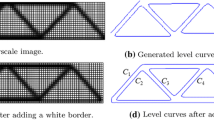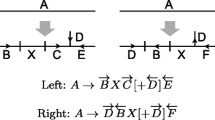Abstract
Topology optimization is a tool that supports the creativity of structural-designers and is used in various industries, from automotive to aeronautics, to reduce design iterations towards obtaining the optimal structure layout. However, this tool requires both time and experience to interpret the results into manufacturable and reliable structure layout. To improve this aspect, an interpretation support tool is being developed by our research team based on industrial knowledge and axiomatic design principles. This design tool will be very useful for aircraft structure development, for instance, as it aims to help the structural designer in the conception of stiffened panels. The tool has been divided into three modules: feature recognition, feature analysis and design support. This paper presents the first of the three modules that identifies the trusses of the optimized topology in terms of truss recognition algorithms. The purpose of the truss recognition algorithm is to translate the densities of the element of the optimized topology (low-level abstraction) to a skeletal structure (high-level abstraction) that contains nodes and branches that describe the same topology as the optimized topology. It should also ensure that the structural skeleton retains connectivity with loads and boundary conditions. The information may then be used by the design support tool for analysis, comparison, decision-making, design and optimization purposes. To do so, a novel image-based method using a binary skeleton is proposed. For this work, we identified multiple limitations existing in similar solutions and we mitigated them. Therefore, a new skeletonization method is proposed, which is specifically designed for truss recognition in the optimized topology. The capabilities of the skeletonization method are demonstrated by comparing it with existing methods, and the truss recognition algorithm is used with a test case exhibiting the algorithm’s capabilities on an airplane wing box rib.















Similar content being viewed by others
References
Altair (2017) Release 2017.2.0. Altair Engineering, Detroit
Arcelli C, Cordella L, Levialdi S (1975) Parallel thinning of binary pictures. Electron Lett 11(7):148
Barbieri L, Bruno F, Muzzupappa M, Cugini U (2008) Design automation tools as a support for knowledge management in topology optimization. In: ASME 2008 international design engineering technical conferences and computers and information in engineering conference, American Society of Mechanical Engineers, pp 1227–1234
Bendsoe MP, Sigmund O (2004) Topology optimization: theory, methods and applications. Springer, Berlin, Heidelberg
Bremicker M, Chirehdast M, Kikuchi N, Papalambros P (1991) Integrated topology and shape optimization in structural design. J Struct Mech 19(4):551
Bruhn EF (1973) Analysis and design of flight vehicle structures. G.W. Jacobs, Philadelphia
Buchanan S (2007) Development of a wingbox rib for a passenger jet aircraft using design optimization and constrained to traditional design and manufacture requirements. In: Proceedings of CAE technology conference
Chirehdast M, Papalambros PY (1992) A note on automated detection of mobility of skeletal structures. Comput Struct 45(1):197
Chou YH, Lin CY (2010) Automated structural optimization system for integrated topology and shape optimization. Struct Multidiscip Optim 40(1):215
Deaton JD, Grandhi RV (2014) A survey of structural and multidisciplinary continuum topology optimization: post 2000. Struct Multidiscip Optim 49(1):1
Dugré A (2014) A design process using topology optimization applied to flat pressurized stiffened panels. Master’s thesis, École Polytechnique de montréal, Montreal
Dugré A, Vadean A et al (2016) Challenges of using topology optimization for the design of pressurized stiffened panels. Struct Multidiscip Optim 53(2):303
Gedig M (2010) A framework for form-based conceptual design in structural engineering. Ph.D. thesis, University of British Columbia. https://doi.org/10.14288/1.0063122
Guo X, Zhang W, Zhang J, Yuan J (2016) Explicit structural topology optimization based on moving morphable components (MMC) with curved skeletons. Comput Methods Appl Mech Eng 310:711
Guo X, Zhang W, Zhong W (2014a) Doing topology optimization explicitly and geometrically—a new moving morphable components based framework. Comput Methods Appl Mech Eng 272:354
Guo X, Zhang W, Zhong W (2014b) Explicit feature control in structural topology optimization via level set method. J Appl Mech 81(8):081009
Hsu YL, Hsu MS, Chen CT (2001) Interpreting results from topology optimization using density contours. Comput Struct 79(10):1049
Huang X, Xie Y (2010) Evolutionary topology optimization of continuum structures. Wiley, Chichester
Inc AE (2016) Optistruct User’s Guide. Altair. Topography Optimization
Johnsen S (2013) Structural topology optimization. Master’s thesis, Norwegian University of Science and Technology
Koguchi A, Kikuchi N (2006) A surface reconstruction algorithm for topology optimization. Engineering with Computers 22(1):1
Krog L, Tucker A, Kemp M, Boyd R (2004) Topology optimization of aircraft wing box ribs. In: 10th AIAA/ISSMO multidisciplinary analysis and optimization conference. Albany, pp 2004– 4481
Larsen S, Jensen CG (2009) Converting topology optimization results into parametric CAD models. Comput-Aided Des Applic 6(3):407
Lin CY, Chou YH (2008) Automated structural optimization system for integrated topology and shape optimization. J Chin Inst Eng 31(5):745
Liu J, Ma Y (2016) A survey of manufacturing oriented topology optimization methods. Adv Eng Softw 100:161
Mandhyan A, Srivastava G, Krishnamoorthi S (2017) A novel method for prediction of truss geometry from topology optimization. Engineering with Computers 33(1):95
Mass Y, Amir O (2017) Topology optimization for additive manufacturing: accounting for overhang limitations using a virtual skeleton. Addit Manuf 18:58
Mostafavi S, Morales Beltran M, Biloria N (2013) Performance driven design and design information exchange. In: Proceedings of the 31st international conference on education and research in computer aided architectural design in Europe. Education and Research in Computer Aided Architectural Design in Europe, pp 117–126
Mulani SB, Slemp WC, Kapania RK (2013) EBF3PanelOpt: an optimization framework for curvilinear blade-stiffened panels. Thin-Walled Struct 63:13
Norato J, Bell B, Tortorelli D (2015) A geometry projection method for continuum-based topology optimization with discrete elements. Comput Methods Appl Mech Eng 293:306
Olason A, Tidman D (2010) Methodology for topology and shape optimization in the design process. Master’s thesis, Chalmers University of Technology
Papalambros PY, Shea K. (2005). In: Antonsson EK, Cagan J (eds) Formal engineering design synthesis. Cambridge University, Cambridge, pp 93–125
Yi G, Kim NH (2017) Identifying boundaries of topology optimization results using basic parametric features. Struct Multidiscip Optim 55(5):1641
Yildiz A, Öztürk N, Kaya N, Öztürk F (2003) Integrated optimal topology design and shape optimization using neural networks. Struct Multidiscip Optim 25(4):251
Zhang J, Wang B, Niu F, Cheng G (2015) Design optimization of connection section for concentrated force diffusion. Mech Based Des Struct Mach 43(2):209
Zhang W, Zhong W, Guo X (2014) An explicit length scale control approach in SIMP-based topology optimization. Comput Methods Appl Mech Eng 282:71
Acknowledgements
The authors wish to thank Stelia Amérique du Nord and Bombardier as industrial collaborators in this project. We would also like to thank the CARIC and MITACS for their funding of our project: MDO-1601: MUltidisciplinary Framework for Optimization of wingboX – 1a [IT07469].
Author information
Authors and Affiliations
Corresponding author
Additional information
Publisher’s Note
Springer Nature remains neutral with regard to jurisdictional claims in published maps and institutional affiliations.
Rights and permissions
About this article
Cite this article
Gamache, JF., Vadean, A., Noirot-Nérin, É. et al. Image-based truss recognition for density-based topology optimization approach. Struct Multidisc Optim 58, 2697–2709 (2018). https://doi.org/10.1007/s00158-018-2028-x
Received:
Revised:
Accepted:
Published:
Issue Date:
DOI: https://doi.org/10.1007/s00158-018-2028-x




